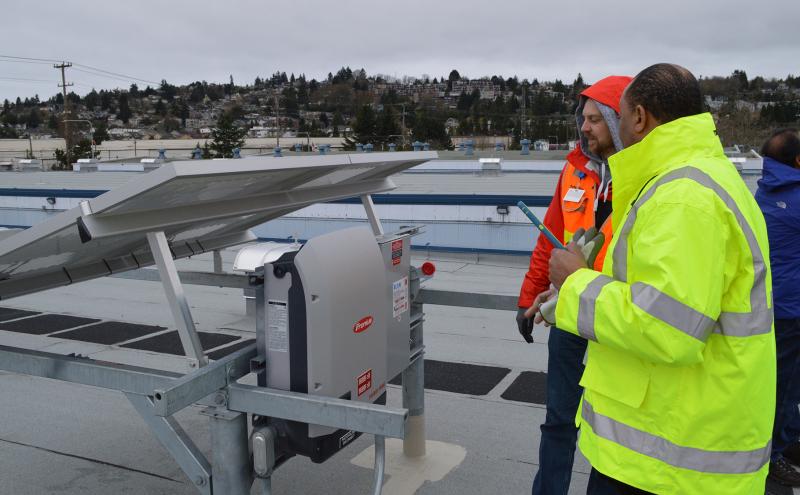
Port of Seattle Commissioners today passed an Energy and Sustainability Motion that charts a new course toward the Port’s commitments to reduce greenhouse gas emissions, enhance sustainability and assess new opportunities for sourcing renewable energy. One of the most tangible aspects of progress on sustainability at the Port is the new solar array currently being installed at Fishermen’s Terminal. The Port’s proposed 2018 budget includes an even larger project to add solar energy to the roof of its Pier 69 building.
“In addition to reducing the Port’s carbon emissions and working to reduce the competing demands on Washington’s hydropower system, these projects demonstrate how the Port can lead efforts to reduce the increasingly obvious impacts of climate change on the environment and our quality of life,” said Port of Seattle Commissioner Fred Felleman, who co-chairs the Port’s Energy and Sustainability Committee with Commissioner Courtney Gregoire.
"Today's action reinforces the Port of Seattle's commitment to sustainable economic growth and should encourage expanded innovation in green technology. From biofuels at Sea-Tac Airport to solar panels at Fishermen's Terminal, we look forward to strengthening partnerships to make our region a market leader in the green economy,” Commissioner Gregoire added.
The Motion will direct the Port of Seattle to:
- Develop a Sustainability Evaluation Framework to assist the Commission helping the Port meet its greenhouse gas reduction and sustainability goals by increasing the transparency of project impacts.
- Select up to four pilot projects, divided between the airport and maritime, to identify the framework and process that incorporates environmental and societal components in design and decision-making for Port construction and operations. The solar project at Pier 69 should be selected as the first pilot project to test the Port’s new evaluation framework.
- Ensure sufficient resources to track greenhouse gas reduction and implement sustainable design principles.
- Expand our carbon reduction emission goal in the Port’s Century Agenda to include indirect emissions. The Port’s goal is for Port-controlled and indirect emissions to be carbon neutral or carbon negative by 2050.
- Increase collaboration with the Northwest Seaport Alliance through the Sustainability Center of Expertise.
Caption: Rendering of solar power array on Fishermen’s Terminal Net Shed 5. The solar panel installation should generate approximately 11,000 kWh of power annually, enough to power the building’s operations. A Washington State based company manufactured the solar panels and a local company will perform installation. Completion: early 2018.
Caption: Watch local solar experts and Port of Seattle Commissioner Fred Felleman describe current and future renewable energy and sustainability projects at the Port of Seattle.
Caption: Rendering of solar power array on Port of Seattle’s Pier 69 office building. The solar panel installation could generate approximately 320,000 kWH of power annually and defer 11,000 lbs. of CO2. The project, if approved, would be partially funded by a grant from Washington State Department of Commerce.
“The Port knows that a more prosperous future is also a cleaner, more sustainable one,” said Vlad Gutman-Britten, Washington Director of Climate Solutions. “These policies put the Port of Seattle on a path towards environmental leadership that reflects the values of this region.”
The Energy and Sustainability Motion marks a major milestone for the Port, which two years ago began significant internal, policy and operational changes that will contribute to a healthier environment and communities. Significant conservation and sustainability actions from the past two years have included:
- Creating a consolidated Sustainability Center of Expertise to better share information and strategies between environmental experts in aviation and maritime;
- Establishing the new policy-making Energy & Sustainability Committee that includes Port Commissioners, staff and was advised by external stakeholders;
- Creating a first-of-its kind Marine Stormwater Utility, which relies on tenants and business unit fees to assess, repair and improve stormwater infrastructure, including adding green infrastructure to manage stormwater;
- Setting more ambitious goals for reducing Port-controlled carbon emissions;
- Increasing energy efficiency through upgrades and new equipment, including converting CNG buses to electric;
- Pursuing opportunities to supply sustainable aviation biofuel to all airlines fueling at Sea-Tac Airport;
- Sourcing new wind-powered electricity, renewable natural gas and renewable diesel; and
- Improving the walkway between public transit stations and the airport terminal by adding an electric cart shuttle, increasing wayfinding, adding weatherization panels and improving lighting.
The Port of Seattle set a goal to be the greenest, most energy efficient port in North America. The Port’s environmental programs cover air quality, energy, clean water, habitat and wildlife management, noise abatement, recycling and solid waste management and cleaning up industrial contamination. In addition to maintaining its aviation and maritime facilities, the Port manages 24 acres of waterfront parks using organic landscaping practices.

